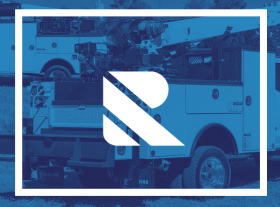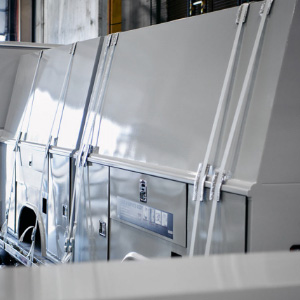You already know how expensive operating your fleet is. Unless you do a fleet management cost analysis, you won’t know the best ways to stay within your budget. Identifying areas of improvement will help you with cost-cutting. Even if you don’t know where to start, you can improve your fleet’s efficiency while spending less — the following tips will help you do so.
1. Consider Retreading Tires
Tires, especially for fleet trucks, account for a significant portion of your fleet’s costs. Instead of purchasing new tires when the old ones wear out, retread the radial ply casings instead. When you retread, you’ll increase the mileage until you need to purchase a new set of tires by 120,000 miles, and the cost to retread tires comes at just over one-third the price of buying new tires. Retreading is a great way to save money on tires without giving up the safety of your fleet.
2. Drop Unnecessary Vehicles
Cutting your fleet size can save thousands over the life of the vehicles. If you have trucks that you don’t use as often, removing them from the fleet could lower your fleet spending between $5,000 and $8,000 annually per vehicle.
If you don’t think you can get rid of any fleet vehicles, see if some routes could double up. Could drivers share a vehicle? Do you have workers on morning and afternoon shifts who could both use the same vehicle?
When you remove vehicles, naturally other fleet trucks will take on more mileage. The added use of these trucks could increase their operating costs, but the increase in costs will not surpass the amount you save from eliminating vehicles. Overall, you can expect to lower total ownership costs by at least five percent.
3. Reduce Mileage
While enforcing personal use of company vehicles seems daunting, GPS-enabled apps installed on your workers’ phones may help. Cut mileage on fleet vehicles by combining trips and improving the efficiency of multi-stop vehicles. The delivery company UPS has a navigation system called ORION that improves its drivers’ routes. Each route shows an average decrease of six to eight miles.
The company’s trucks rarely make left turns. Spending too many hours waiting at a left-turn signal wastes fuel over the years. By making only right turns, the company’s trucks cut idling time, save millions of gallons of fuel across the fleet and reduce emissions.
4. Check Tire Pressure
The tire pressure matters to your fleet vehicles’ fuel economy more than you think. For every one psi you have in a vehicle’s tires below the recommended value, fuel efficiency drops by 0.2%. This proportion adds up quickly, but by maintaining the manufacturer’s recommended tire pressure, you can improve fuel efficiency up to three percent.
Don’t forget that temperatures will increase or decrease tire pressure. Your fleet vehicles need their tire pressure checked daily because cold temperatures will drop the pressure, while very hot temperatures will raise it. Equip all vehicles with tire pressure gauges, and encourage drivers to check the pressure regularly and before long routes.
5. Reduce Loads
To save on fleet fuel economy, only have the equipment your workers need onboard fleet vehicles. Carrying excessive equipment or materials from another job can weigh down the truck, lowering fuel efficiency. Train employees to empty the truck of gear from previous tasks, especially heavy elements and tools. If your vehicles have roof racks, remove them when they’re not in use. The added drag from an empty roof rack increases fuel usage by up to 30%.
Provide your workers with a secure storage area at the fleet base where they can keep tools and other equipment that’s not in use. Doing so will prevent your trucks from turning into rolling storage cabinets with lower fuel mileage.
6. Train Drivers in Fuel-Efficient Driving Methods
One of the most critical parts of your fleet’s fuel economy sits behind the wheel daily. Train each driver in proper driving habits that help reduce fuel mileage. Discourage aggressive driving. A study of drivers in light-duty vehicles showed aggressive driving habits — rapid braking, fast acceleration and speeding — reduced fuel efficiency between 15 and 30% at highway speeds and 10 to 40% in city traffic.
When looking at fleet fuel consumption, these driving habits equated to losing between $0.25 and $1 per gallon of fuel. Now multiply that across your fleet to get an idea of the amount of money aggressive driving is wasting you.
7. Install Vehicle Tracking Systems
Adding a vehicle tracking system to each of your fleet vehicles will let you monitor whether your drivers speed on their routes, and controlling speed helps to reduce the vehicles’ fuel usage. For example, driving at 70 mph will use up to 15% more fuel than traveling at 50 mph. Speeding at 80 mph uses up to 25% more fuel than going at 70 mph. Vehicle tracking systems can send you a signal when a driver speeds, so you can correct the action immediately via radio or phone.
8. Check Vehicle Alignment
Improperly aligned vehicles cause uneven wear on tires while making the ride less comfortable for the driver. Alignment can shift during towing. Other alignment-altering incidents include hitting a curb or getting into an accident. Regularly check the alignment of all fleet vehicles, and make repairs if needed. Failing to do so will result in more frequent tire replacements and reduced fuel efficiency for the affected vehicles.
9. Reduce Warmup Times
Except when temperatures drop below zero degrees Fahrenheit, you don’t need to run the engine for more than 10 minutes to warm it up. Additionally, you should not rev the engine during warmup. Both actions reduce the fuel efficiency of the vehicle. Skip engine warmups in warm weather when the engine doesn’t need it. Also, don’t leave the engine running at the end of the trip.
10. Compare Company Fuel Cards
When it comes to refilling your fleet vehicles, having your workers use a company fuel card will make it easier for you to track spending. Research the cards available carefully — like consumer credit cards, fuel cards come with benefits to attract your business. Look for those that offer discounts at certain fuel stores. For example, BP’s business fuel card will save you $0.06 per gallon on fuel at BP locations, and the Fuelman diesel card cuts the price per gallon by $0.15 if the driver is fueling at Fuelman stores.
Using a fleet fuel account will let you give drivers their company fuel cards. Instead of wasting time and money to reimburse employees for fuel purchases, you can take advantage of the fact that the fuel card report makes it easier to track spending.
11. Pay Attention to Warranties
Keep track of all your vehicles’ warranties. Software will help you maintain a database of all your vehicles and their warranties. You need to know how long the warranties last, what they cover and how to redeem them. Should one of your fleet vehicles have a problem or need a part replaced, you could overspend by not taking advantage of warranty coverage.
12. Consider Resale Value
Hopefully, you won’t have the fleet vehicles until they completely breakdown. Choose fleet vehicles that will retain resale value. Adding customized truck bodies and similar improvements can help reduce the rate of depreciation. Keeping vehicles in good condition will also help. Before making a purchase, research the vehicles in your area that have the best resale value and compare their purchase and operating costs to find the best fleet vehicles for your company.
13. Double Your Vehicle Use
When you’re ordering new vehicles for your fleet, choose white to save on the costs of a customized paint job. Use vehicle wraps or simple logos on your fleet vehicles to identify them as your company’s and to provide your business with free advertising.
Your customers will feel safer when a worker pulls up in a clearly identifiable fleet vehicle, and you can spread your name throughout the area your workers drive in. Don’t forget to include your company’s phone number and website on the truck to give people a way to contact you.
14. Use Training Programs to Prevent Accidents
The last thing you want is an accident with one of your fleet vehicles to take the truck or driver out of service. Conduct several training programs for your workers to educate them on safe driving techniques. Refresh their memories with regular meetings and information updates. By keeping your workers safer behind the wheel, you can protect them as well as your investment in your fleet.
15. Make the Shift to Alternative Fuels
If your fleet uses several diesel trucks, you could save money over time by slowly replacing those trucks with ones that run on biomethane compressed natural gas (CNG). This fuel source already has use in many vehicles in the United States. While each vehicle that uses biomethane CNG costs 50% more than a comparable diesel truck, the fuel used costs 40% less than diesel. The environment also benefits from this fuel source because biomethane CNG releases 70% less carbon dioxide than diesel.
How long it will take your company to recoup the extra cost of purchasing these vehicles depends on several factors, including the number of trucks and mileage. One UK supermarket, Waitrose, expects its new fleet of biomethane CNG trucks to cover the extra cost in just three years of use.
16. Upgrade Existing Vehicles
Instead of purchasing new trucks, upgrade the ones you already have. Customized bodies for trucks can transform your vehicles into highly productive, specialized conveyances for your workers and all their equipment. Adding a panel body can dramatically increase room on a truck. Changing to a service body will integrate locking toolboxes into the sides of the vehicle for secure storage without giving up the bed for equipment.
17. Manage Repair Vendors
Not all fleets have their own mechanic. If yours does not, you’ll need to have a designated vendor for service and repairs. Choose a mechanic who offers quality service and fair prices. Ask about bulk discounts for servicing your fleet.
To avoid paying too much for repairs, always require that all repairs get your authorization first. Do not allow drivers to take vehicles to other mechanics except in dire emergencies. Controlling where your vehicles get repairs will help you keep maintenance costs down.
18. Increase Preventative Maintenance Intervals
Preventative maintenance can greatly reduce your fleet’s number of breakdowns while driving, but you don’t need to have every vehicle serviced every 3,000 miles. Newer vehicles can last longer between oil changes and similar chores. For light-duty vehicles, scheduling maintenance every 6,000 to 7,000 miles will suffice, especially if you use more durable synthetic oil. If your fleet has vehicles that perform more than light duty, you can decrease the mileage between services. For heavy-duty trucks, changing the oil every 3,000 miles is a necessity.
Regardless of when you schedule preventative maintenance, stick closely to the timetable. By extending the time between oil changes, you can save money, but if you go too long between services, your fleet vehicles could have costly problems. Don’t allow your vehicles to go farther than 7,000 miles before receiving preventative maintenance. In addition to regular service, always have drivers perform a checklist, and send vehicles for repairs if any problems arise.
19. Add Newer Vehicles to Your Fleet
When you need to replace vehicles in your fleet, choose newer models instead of older ones. The newer vehicles will have lower mileage on them if they’re purchased used. Even more importantly, newer vehicles have better fuel efficiency than those made years ago.
Over just five years, from 2012 to 2017, the average fuel economy across all manufacturers increased from 23.6 mpg to 24.9 mpg. Even with fuel efficiency improving, manufacturers have found ways to maintain the weight of their vehicles and still increase horsepower. This information is good news for your hard-working fleet vehicles that may require as much horsepower as possible for hauling tools and equipment.
20. Reduce Idle Time
Idling can significantly reduce your fleet’s total fuel efficiency. If waiting for more than a minute, a driver should shut off the engine to prevent needles idling. On a 100-mile trip, 30 minutes of idling, whether in traffic, at lights or in a parking lot, can drop fuel efficiency by one-third.
Make Your Fleet More Efficient
When you take these tips for how to reduce fleet costs into consideration, you could increase your profits or have enough for fleet expansion or improvement. As already noted, having a more cost-efficient fleet requires you to pay attention to fuel economy. Another method to reduce your costs comes with thinking about the future resale value of your vehicles by improving how effective they function in their intended roles. Installing truck bodies will customize your fleet into a more valuable, harder working collection of vehicles.
At Reading Truck, we provide fleets like yours with the body modifications they need to be more efficient at what they do. We offer customizable truck bodies that can provide secure storage, haul landscaping equipment, tow vehicles and much more. If you want more information about any of our products for your fleet, contact our fleet management team.





